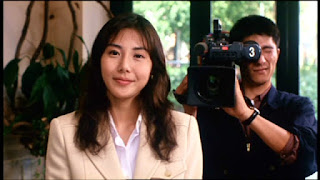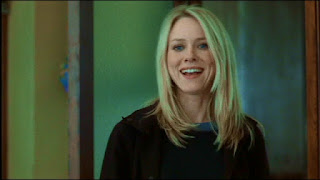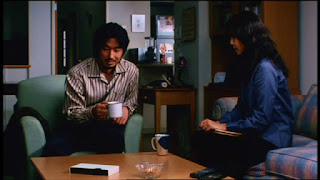Ringu
Starring: Nanako Matsushima, Miki Nakatani, Yûko Takeuchi, Hitomi Satô, Yôichi Numata, Yutaka Matsushige, Katsumi Muramatsu, Rikiya Ôtaka, Masako, Daisuke Ban, Hiroshi Sakuma, Yûrei Yanagi, Yôko Ohshima, Kiriko Shimizu, Makoto Kakeda, Rie Ino'o, Hiroyuki Tanabe, Miwako Kaji, Yôko Honma, Asami Nagata, Yukiko Shimodaira, Keiko Yoshida, Yoshiko Matsumaru, Ayumu Naose, Maki Ikeda, Takashi Takayama, Chihiro Shirai, Toshihiko Takeda, Mantarô Koichi, Shin'ichi Noda, Shigefumi Nakai, Yûki Takahata, Taku Kobayashi, Kazuhiro Yokoyama, Mizuho Kinoshita, Toshinori Yoshino, Asami Ishikawa, Hiroyuki Sanada
Director: Hideo Nakata
Omega Project, Imagica, Asmik Ace Entertainment, Pony Canyon, Toho Company, Japan, 1998.
The Ring
Starring: Naomi Watts, Martin Henderson, David Dorfman, Brian Cox, Jane Alexander, Lindsay Frost, Amber Tamblyn, Rachael Bella, Daveigh Chase, Shannon Cochran, Sandra Thigpen, Richard Lineback, Sasha Barrese, Tess Hall, Adam Brody, Alan Blumenfeld, Pauley Perrette, Joe Chrest, Ronald William Lawrence, Stephanie Erb, Sara Rue, Lindsey Stoddart, Joe Sabatino, Joanna Lin Black, Maura McNamara, David Povall, Keith Campbell, Chuck Hicks, Michael Spound, Gary Carlos Cervantes, Aixa Clemente, Art Frankel, Billy Lloyd, Coleen Maloney, Catherine Paolone, Guy Richardson
Director: Gore Verbinski
DreamWorks SKG, Parkes+MacDonald Image Nation, BenderSpink, USA, Japan, 2002.
I recently came across Smartling, a translation software company, that translates websites or applications as a whole to preserve the original intent, so that the content can be easily shared with a global audience, which got me thinking about Hollywood remakes of films and the use of language in them. Often the remakes are called lazy film making attempting to Americanize movies from other countries, removing the need of subtitles and replacing the original actors with better known Hollywood superstars. Often this is also true when the remake either loses the idea of the original story or attempts to carbon copy the original film without adding anything original into the story. There are of course many entertaining or artistically remarkable remakes such as "12 Monkeys", "True Lies", "The Departed", "Let Me In", "Insomnia", "Some Like It Hot" and "The Magnificent Seven" that are equal or sometimes even better than the originals.
In Finland we watch movies with subtitles and original audio tracks (except some children's cartoons) so we are accustomed to "reading" the movies. Because we do not dub the movies, we can enjoy the original audio tracks. I remember watching some Schwarzenegger films from German TV-channels: "Komm mit mir wenn Du leben willst!" or watching Chuck Norris films dubbed in Polish where one guy reads all the lines. Luckily we not have to suffer from those kind of localisations (there was once an attempt to dub soap opera "Bold and the Beautiful" in Finnish, but after angry viewer feedback the experiment ended fast). Finnish remakes are quite rare, but some still exist! Some examples of our own remakes are "Luokkakokous" (remake of Danish "Klassefesten" or remakes in the 1940s "Uuteen Elämään" and "Avioliittoyhtiö" (remakes of Swedish films "...Som En Tjuv Om Natten" and "Så Tuktas En Äkta Man.")
As an example of well made Hollywood remake I decided to write about Hideo Nakata's modern Japanese horror classic "Ringu" and its American remake "The Ring" by Gore Verbinski. Both films "Ringu" and "The Ring" are loosely based on novel "Ring" by Koji Suzuki. As the plotlines are roughly equal the movies are reviewed together. To separate characters, locations etc. of the different versions the names referring to the Japanese version are marked red and to American version are marked cyan respectively.
Two teen girls Tomoko (Yūko Takeuchi) and Masami (Hitomi Satō) / Katie (Amber Tamblyn) and Becca (Rachael Bella) talk about cursed video tape that kills the watcher after one week. Rumours tell that many teenagers have died after watching the tape. Tomoko / Katie has watched it so she dies. Dead girl's aunt, reporter Reiko Asakawa (Nanako Matsushima) / Rachel Keller (Naomi Watts) begins to investigate the roots of the urban legend. She has young son Yoichi (Rikiya Ôtaka) / Aidan (David Dorfman) who was close friend of Tomoko / Katie. After Tomoko's / Katie's funeral Reiko / Rachel hears that also other of the late girl's friends have died mysteriously. All of them visited rental cabin in Izu / Shelter Mountain Inn.
 |
| Tomoko and Masami |
 |
| Katie and Becca |
 |
| Reiko Asakawa |
 |
| Rachel Keller |
Reiko / Rachel investigates the cabin and finds a home recorded video tape. She watches it and receives a phone call. She now has one week to solve the mystery before she dies. She asks help from her ex-husband Ryūji Takayama (Hiroyuki Sanada) / Noah (Martin Henderson). She shows him the tape. Ryūji / Noah has his feet on the ground and does not believe that watching a video tape can cause supernatural deaths.
 |
| Reiko and Yoichi |
 |
| Aidan |
 |
| Ryūji Takayama |
 |
| Noah |
The killer video consists of random images such as mirror image of woman combing hair, ladders and bugs, moving text with the word "eruption", dead horses, hooded man pointing with his finger ("Pointy-kun") and speaking in dialect, mutilated fingertips, crawling people, woman jumping from a cliff, eye with word Sada and image of well. To Reiko's / Rachel's horror Yoichi/ Aidan also watches the tape. Saving her son provides extra motivation for solving the mystery. Reiko gets a clue about volcanic eruption forty years ago (in American version volcano is replaced with lighthouse and dead horses).
 |
| Crawling words |
 |
| The ladder |
Everything started in Izu Ōshima Island / Moesko island. Woman named Shizuko (Masako) had psychic skills but she was shunned by the locals. Woman named Anna (Shannon Cochran) was raising horses when tragedy hit and things started to go wrong. She had also daughter Sadako (Rie Ino'o) / Samara (Daveigh Chase) who is somehow responsible for the deaths. Only Sadako / Samara vanished decades ago. On the island lives still Sadako's uncle Takashi Yamamura (Yôichi Numata) / Samara's father Richard Morgan (Brian Cox). He knows the terrible secret behind the mystery.
 |
| The tape |
 |
| Takashi Yamamura and Ryūji |
 |
| Richard Morgan |
As I do not speak Japanese it is hard to tell about the language usage in "Ringu" except for some general remarks. In the Japanese version the characters speak standard Japanese, however "Pointy-kun's" Hachijō-dialect (spoken in Izu Ōshima Island) has a special importance to the story. Hachijō is an ancient language that is divergent from standard Japanese, so it must sound mysterious to the Japanese. The Japanese version has very little of dialogue outside the conversations relating to the mystery. Reiko is restrained Japanese woman, American Rachel is more temperamental and reacts more emotionally to the creepy incidents. Reiko also shows her feelings in the end, but in more restrained way. As such Reiko obeys Japanese manners and her way of speaking is generally polite, whereas Rachel's way of speaking varies from resolute arguing to empathetic expressions. The American version has more casual talk and also Rachel's and Noah's past is revealed a bit more. Rachel seems to be more open person than more reserved Reiko. Aidan has stronger paranormal sense than Yoichi. Yoichi can sense the presence of ghosts. In addition to that, Aidan can draw eerie pictures that foretell future. Aidan expresses his supernatural experiences by replicating them visually. Also the importance of dialogue is further highlighted in "The Ring": while Reiko was investigating an urban legend already before Tomoko died, Rachel first hears about the tape at Katie's funeral from Katie's friends. Katie's mother Ruth (Lindsay Frost) asks Rachel to find out why Katie died giving Rachel the final motive to find the tape.
 |
| Aidan draws creepy pictures |
Also the male protagonists have a bit different sets of skills. Ryūji is mathematics professor having some mind-reading skills that help with the investigations. Noah works as video/photo editor so he provides some technical information about the tape. Noah is more easy-going than Ryūji, while Ryūji acts more mature. They both have a student (and possible lover) Mai Takano (Miki Nakatani) / Beth (Pauley Perrette). In the Japanese version Mai is playful and plays a mathematical prank to Ryūji, but in the American version Beth's role is downplayed. Takashi Yamamura and Richard Morgan are two quite different characters, while Takashi has quilt about the past he is ultimately willing to face it, but Richard just wants to bury the past even if it means burying himself.
 |
| Mai Takano |
 |
| Beth |
There is also difference of how verbal and visual language are used. Although the dialogue in "The Ring" was more informative, the killer videos it is the opposite. "Ringu" uses crucial verbal clues in the killer video but in "The Ring" the visual clues are more important.
The deadly video in Japanese version has textual and spoken but distorted word clues, the American version has more visual clues without words. The Japanese video has more abstract clues that rely on Japanese folktales about sea goblins that drown people. The American video has its own demented logic and more easily explainable clues. As such the deadly video of "The Ring" is more easier for Western viewer, also the overall visual style is more impressive. Also the American version makes use of some Western superstitions such as walking under ladder brings bad luck.
The music of "Ringu" by Kenji Kawai (one of my favourite Japanese soundtrack composers) is neoclassical or ambient with some industrial elements.There is also J-pop song Feels Like 'Heaven' by HIIH during the end credits, I think that this song breaks the mood a bit. The soundtrack of "The Ring" by Hans Zimmer is similarly dark and moody classical, luckily there is not a contemporary rock song ruining the end. Both films use eerie sound effects, although "Ringu" sound effects are creepier.
So how does "The Ring" avoid the pitfalls of remakes?
The deadly video in Japanese version has textual and spoken but distorted word clues, the American version has more visual clues without words. The Japanese video has more abstract clues that rely on Japanese folktales about sea goblins that drown people. The American video has its own demented logic and more easily explainable clues. As such the deadly video of "The Ring" is more easier for Western viewer, also the overall visual style is more impressive. Also the American version makes use of some Western superstitions such as walking under ladder brings bad luck.
The music of "Ringu" by Kenji Kawai (one of my favourite Japanese soundtrack composers) is neoclassical or ambient with some industrial elements.There is also J-pop song Feels Like 'Heaven' by HIIH during the end credits, I think that this song breaks the mood a bit. The soundtrack of "The Ring" by Hans Zimmer is similarly dark and moody classical, luckily there is not a contemporary rock song ruining the end. Both films use eerie sound effects, although "Ringu" sound effects are creepier.
So how does "The Ring" avoid the pitfalls of remakes?
Using (then) relatively little known actors, "The Ring" avoided the casting of overused stars. Although having starred many films before, it was "The Ring" that finally made Naomi Watts a big star. Brian Cox was probably the most well known of the cast back then. The original "Ringu" was effective in its minimalistic approach and brought the Japanese ghost stories to modern ages. "The Ring" fleshes out the characters, making them little bit more realistic as real persons. The American version adds some jump scares and horror effects but neither of them are particularly gory films. Both films rely more on psychological horror and create slowly tightening sense of doom. Although Samara's character is more developed than Sadako, the motives behind the two characters are kept essentially the same. Special effects of "The Ring" offer couple of gimmicks (for example the fly scene and the well scene in the end), but they support the story and do not steal too much attention.
The American version improves some ideas of the original film (having also greater budget). The character of Sadako draws from Japanese ghost stories and her origin is thought to be supernatural. She inherited her psychic powers from her mother. Samara's origin is left vague, and her psychic skills are more emphasized. Also her mother did not have any supernatural skills. Other original ideas in the American version are the story of horses and tale of Samara's father. American version has also a side plot regarding Samara's stay in mental hospital. As tributes to the original "Ringu" some hospital papers have Japanese writing and the tree appearing in the video is Japanese maple. There is also an Asian woman telling Noah that he will die (however she does not refer to supernatural death).
 |
| The horse |
Finally, "The Ring" is a great remake improving and respecting the original movie. Still watching them reveals differences of American and Japanese horror film styles. Both versions are worth seeing as both offer solid atmospheric horror experience.
Ratings:





No comments:
Post a Comment
Thank you for your interest! (All comments are moderated before publishing so please be patient!)